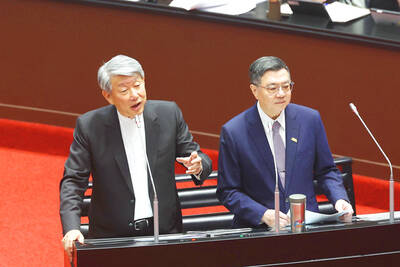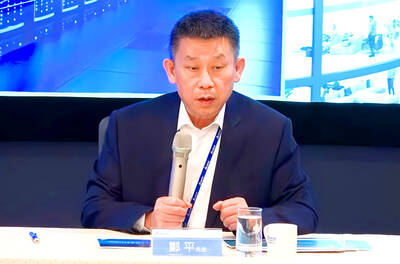A San Francisco startup backed by the billionaire co-founder of HTC Corp (宏達電) is promoting an electric scooter that features a recharging system that failed to catch on for battery-powered cars.
Gogoro Inc (睿能創意) unveiled its Smartscooter this week at the Consumer Electronics Show in Las Vegas. It can go more than 97km without recharging and will be available for sale this year, chief executive officer Horace Luke (陸學森) said.
The company is also developing kiosks where drivers can swap drained battery packs for fresh ones, a task that is much faster than recharging them, Luke said. He expects the scooters to catch on in large cities, especially in Asia.
The world’s biggest cities are “at a tipping point in population density, pollution fallout and rapid expansion,” Luke said in a statement. “It is essential that we reimagine the energy infrastructure.” He declined to discuss prices for the scooter.
Luke was previously chief innovation officer at HTC, and the mobile phone company’s chairwoman Cher Wang (王雪紅) has invested in Gogoro. She and her husband, Chen Wen-chi (陳文琦), are listed together as the 23rd-richest people in Taiwan, with a net worth of US$1.6 billion, according to Forbes.
Gogoro’s battery-swapping model is similar to that of Israel’s Better Place LLC, which went bankrupt in 2013. Drivers of electric cars could exchange drained power packs for fresh ones at Better Place charging stations, which had automated systems to transfer the components.
Gogoro’s kiosks are about the size of a vending machine, and the batteries are small and light enough that people can switch them by hand in less than a minute, Luke said.

Taiwanese suppliers to Taiwan Semiconductor Manufacturing Co. (TSMC, 台積電) are expected to follow the contract chipmaker’s step to invest in the US, but their relocation may be seven to eight years away, Minister of Economic Affairs J.W. Kuo (郭智輝) said yesterday. When asked by opposition Chinese Nationalist Party (KMT) Legislator Niu Hsu-ting (牛煦庭) in the legislature about growing concerns that TSMC’s huge investments in the US will prompt its suppliers to follow suit, Kuo said based on the chipmaker’s current limited production volume, it is unlikely to lead its supply chain to go there for now. “Unless TSMC completes its planned six

Power supply and electronic components maker Delta Electronics Inc (台達電) yesterday said second-quarter revenue is expected to surpass the first quarter, which rose 30 percent year-on-year to NT$118.92 billion (US$3.71 billion). Revenue this quarter is likely to grow, as US clients have front-loaded orders ahead of US President Donald Trump’s planned tariffs on Taiwanese goods, Delta chairman Ping Cheng (鄭平) said at an earnings conference in Taipei, referring to the 90-day pause in tariff implementation Trump announced on April 9. While situations in the third and fourth quarters remain unclear, “We will not halt our long-term deployments and do not plan to

‘SHORT TERM’: The local currency would likely remain strong in the near term, driven by anticipated US trade pressure, capital inflows and expectations of a US Fed rate cut The US dollar is expected to fall below NT$30 in the near term, as traders anticipate increased pressure from Washington for Taiwan to allow the New Taiwan dollar to appreciate, Cathay United Bank (國泰世華銀行) chief economist Lin Chi-chao (林啟超) said. Following a sharp drop in the greenback against the NT dollar on Friday, Lin told the Central News Agency that the local currency is likely to remain strong in the short term, driven in part by market psychology surrounding anticipated US policy pressure. On Friday, the US dollar fell NT$0.953, or 3.07 percent, closing at NT$31.064 — its lowest level since Jan.

The New Taiwan dollar and Taiwanese stocks surged on signs that trade tensions between the world’s top two economies might start easing and as US tech earnings boosted the outlook of the nation’s semiconductor exports. The NT dollar strengthened as much as 3.8 percent versus the US dollar to 30.815, the biggest intraday gain since January 2011, closing at NT$31.064. The benchmark TAIEX jumped 2.73 percent to outperform the region’s equity gauges. Outlook for global trade improved after China said it is assessing possible trade talks with the US, providing a boost for the nation’s currency and shares. As the NT dollar